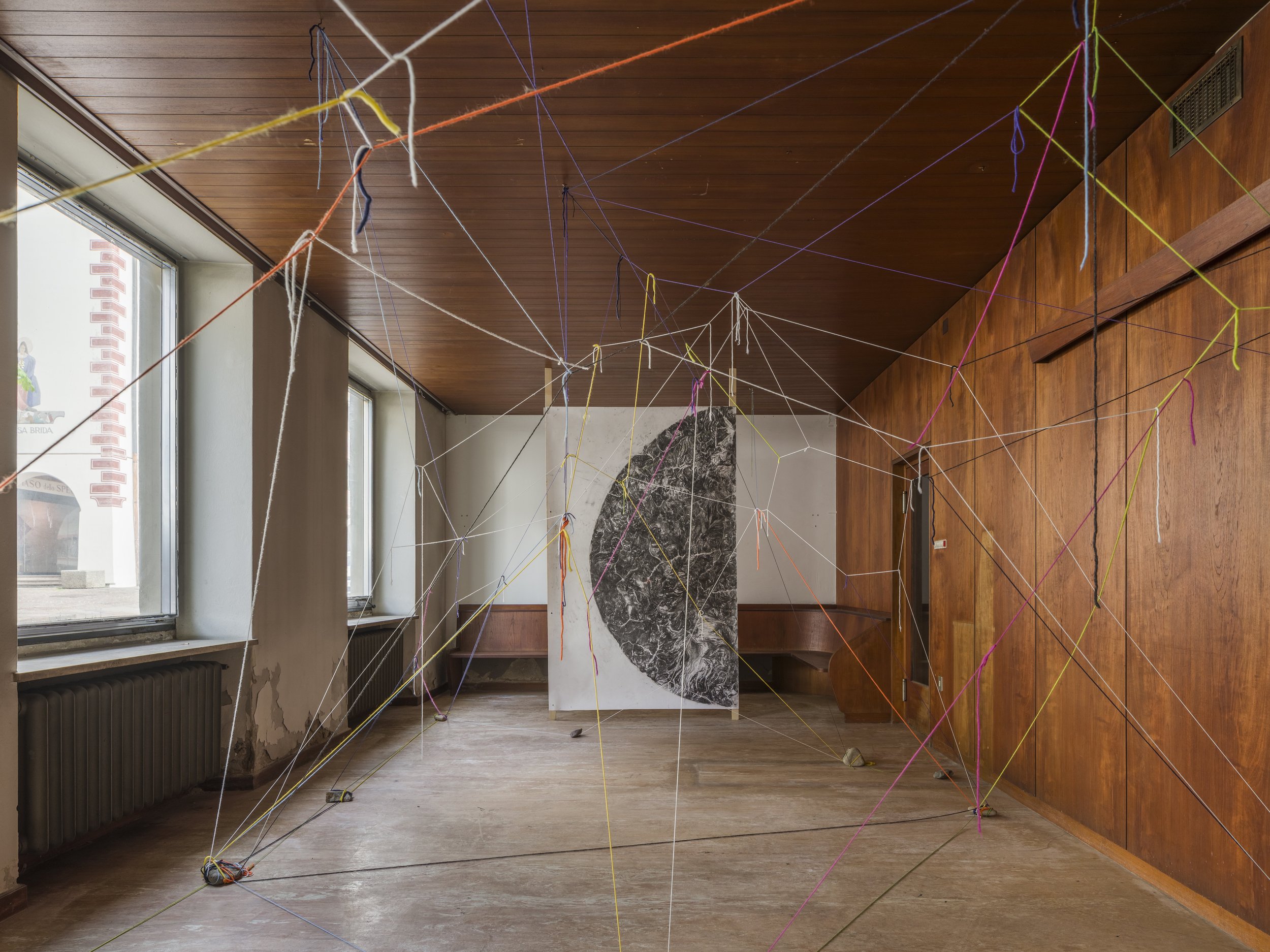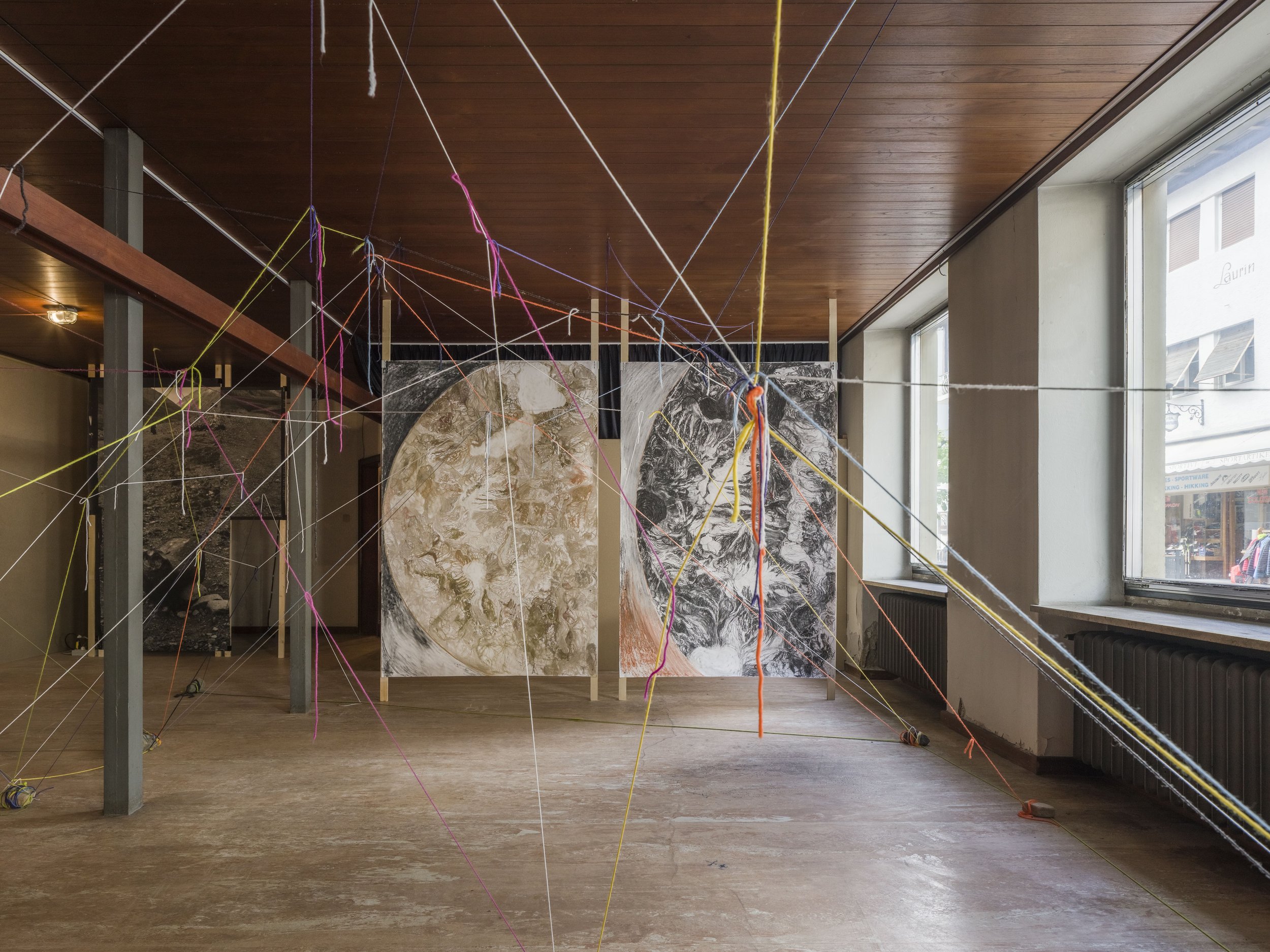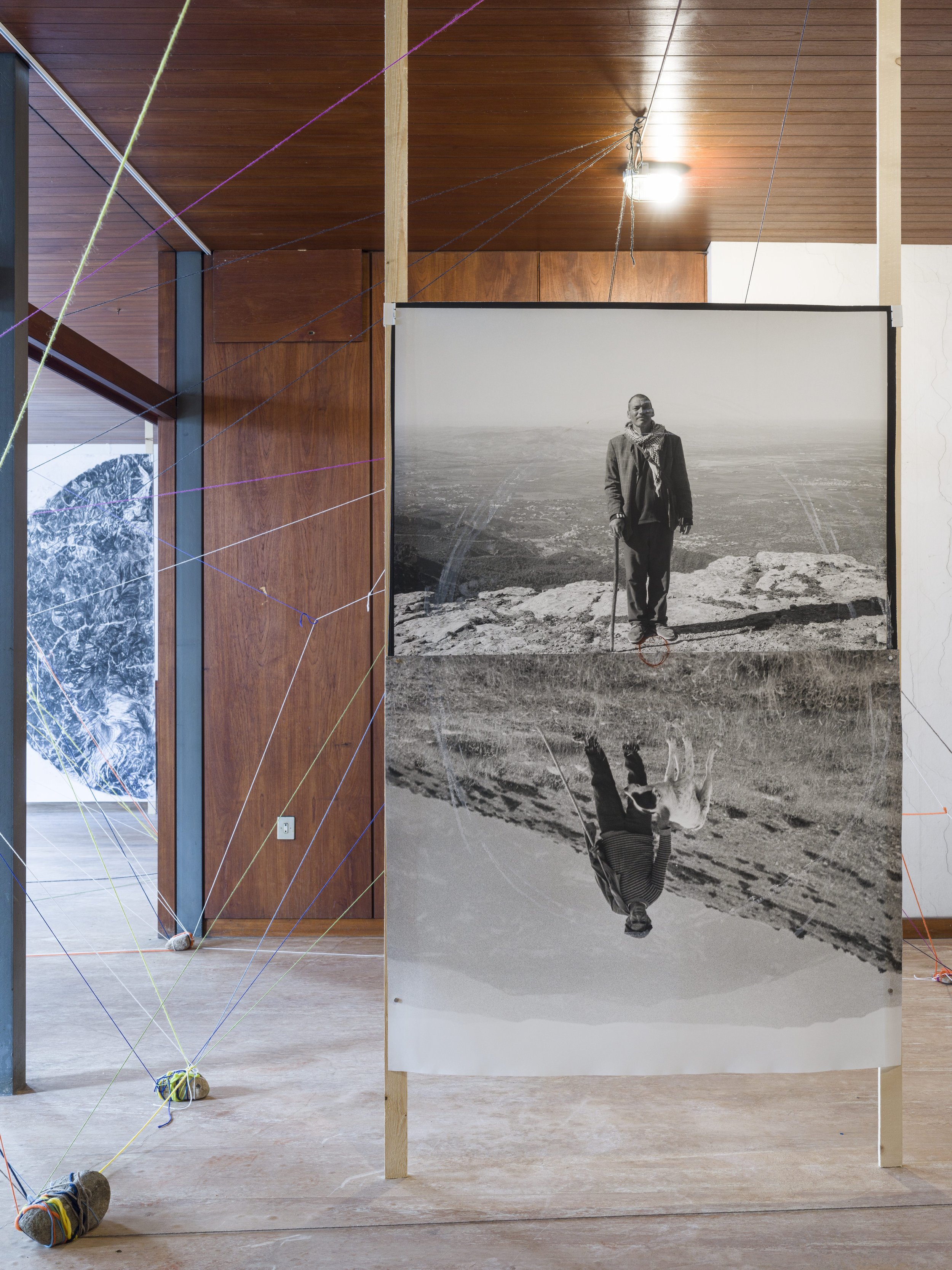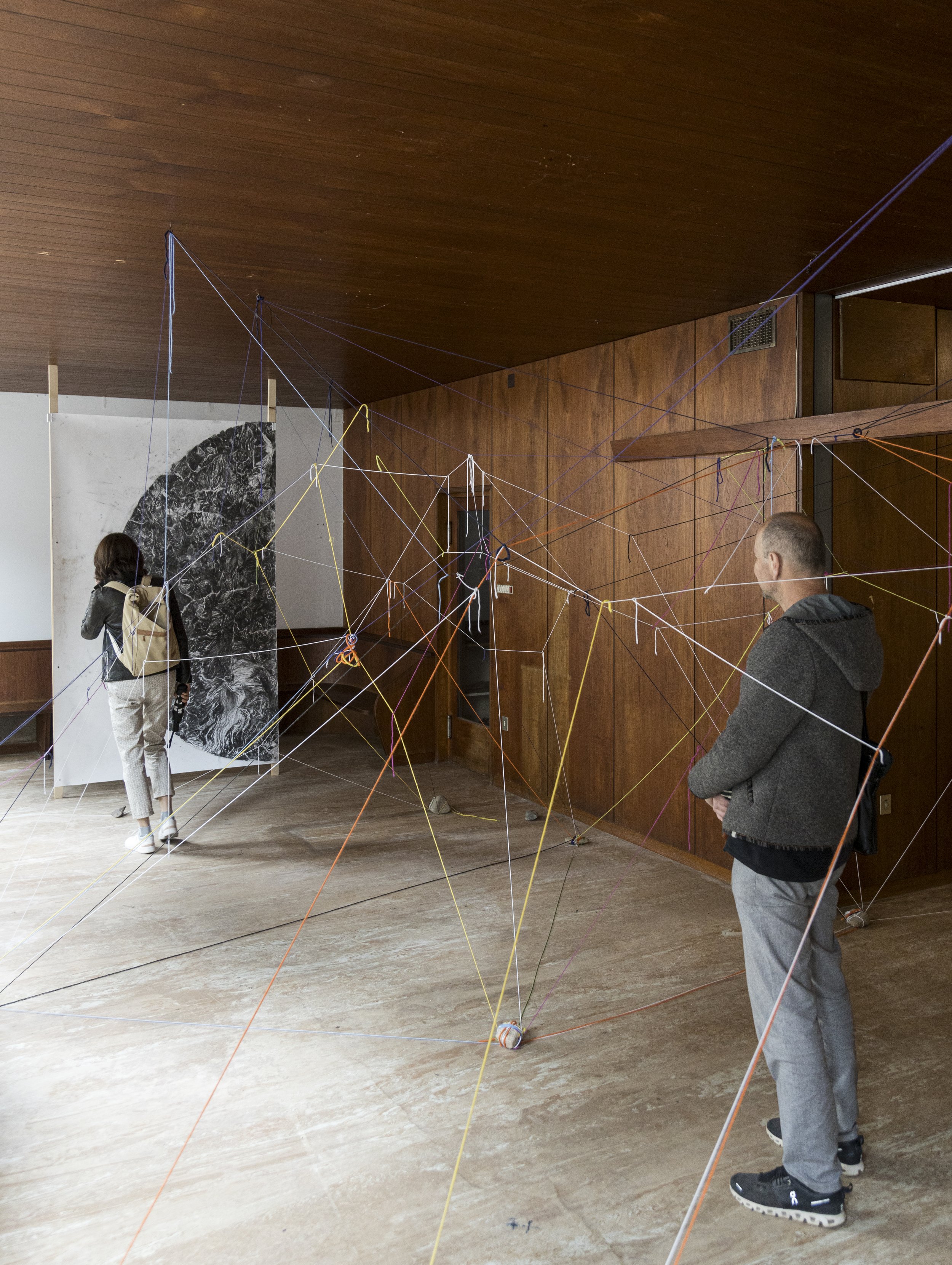
Michael Höpfner, Plateau-A Walking Life, 2024. Installation - Silver Gelatine Prints, Drawings, Collages, Yarn. Variable Dimensions. Commissioned by Biennale Gherdëina 9. Supported by La Boîte, Tunis. Photos by Tiberio Sorvillo

Michael Höpfner, Plateau-A Walking Life, 2024. Installation - Silver Gelatine Prints, Drawings, Collages, Yarn. Variable Dimensions. Commissioned by Biennale Gherdëina 9. Supported by La Boîte, Tunis. Photos by Tiberio Sorvillo

Michael Höpfner, Plateau-A Walking Life, 2024. Installation - Silver Gelatine Prints, Drawings, Collages, Yarn. Variable Dimensions. Commissioned by Biennale Gherdëina 9. Supported by La Boîte, Tunis. Photos by Tiberio Sorvillo

Michael Höpfner, Plateau-A Walking Life, 2024. Installation - Silver Gelatine Prints, Drawings, Collages, Yarn. Variable Dimensions. Commissioned by Biennale Gherdëina 9. Supported by La Boîte, Tunis. Photos by Tiberio Sorvillo
Michael Höpfner
1972, Krems/Donau, Austria
EN Michael Höpfner’s artistic research consists of analogue black-and-white photographs, drawings, installations and sculptures that tell the story ofhis long journeys on foot across the remotest parts of the world, especially inEastern Europe, China and Asia. Equipped with an analogue Hasselblad camera, Höpfner traverses unspoilt natural locations, far away from or abandoned by civilisation, viewing walking as an artistic process in search of the qualities of existence in this austere and modest world. The starting point for this journey was the long period he spent on the Tibetan plateau at an altitude of over 4,500 metres between 2000 and 2008. In an existential quest, his artistic work is closely bound up in his encounters with shepherds and nomads and his immersion in their way of life. As a walker, Höpfner is mindful of the ground beneath his feet and how different worlds are revealed to him little by little. His photographs thus become a means for observing and processing vastness, emptiness and solitude both in detail and at a distance. ForThe Parliament of Marmots, Michael Höpfner explored the mythological, geological and philosophical dimensions ofthe Fanes Plateau in the heart of the Dolomites Nature Park, where the ancientpeople allied with marmots are said to have lived. Starting from the notion of the plateau as a rhizomatic structure and as a “continuous, self-oscillating regionof intensity,” as described by Gilles Deleuze and Félix Guattari inA ThousandPlateaus(1980), Höpfner developed a new anthological work for the rooms of the historic Hotel Ladinia in Ortisei. Alongside the various excursions in ValGardena, the artist also travelled through the Djebel Serj in the Tunisian Atlas mountains. He thus collected new material and at the same time immersed himself in the thousands of negatives and hundreds of notebooks recounting his journeys to the high plateaus, as well as his encounters with pastoral and nomadic populations over the last twenty-five years.
IT La ricerca artistica di Michael Höpfner consiste in fotografie analogiche in bianco e nero, disegni, installazioni e sculture che raccontano i suoi lunghiviaggi a piedi nelle zone più remote del mondo, soprattutto dell’Europa orientale, della Cina e dell’Asia. Munito di una macchina fotografica analogica Hasselblad, Höpfner attraversa luoghi naturali incontaminati, lontani o abbandonati dalla civiltà, considerando il camminare come un processo artistico capace di dare qualità e senso all’esistenza. Il punto di partenza di questa ricerca sono stati i lunghi mesi di permanenza sull’altopiano tibetano a oltre 4.500 metri di altitudine, tra il 2000 e il 2008. In una ricerca esistenziale, il suo lavoro artistico è strettamente connesso all’incontro con pastori e nomadi e all’immergersi nel loro stile di vita. Come camminatore, Höpfner è attento al terreno sotto i suoi piedi e a come i diversi mondi gli si rivelino passo dopo passo. Le fotografie diventano materiali per osservare ed elaborare nei dettagli e a distanza la vastità, il vuoto e la solitudine. PerThe Parliament of Marmots, Michael Höpfner ha esplorato le dimensioni mitologiche, geologiche e filosofiche dell’altopiano di Fanes, nel cuore del ParcoNaturale delle Dolomiti, dove si narra sia vissuto l’antico popolo alleato delle marmotte. Partendo dall’idea dell’altopiano come struttura rizomatica e come“regione continua e auto-oscillante di intensità” descritta da Gilles Deleuze e Félix Guattari inMille piani(1980), Höpfner ha sviluppato un nuovo lavoro antologico per le sale dello storico Hotel Ladinia di Ortisei. Accanto alle diverse escursioni effettuate in Val Gardena, l’artista ha anche attraversato il DjebelSerj, nell’Atlante tunisino. Ha così raccolto nuovo materiale e al contempo si è immerso nelle migliaia di negativi e nelle centinaia di taccuini che raccontano i suoi viaggi sugli altipiani e gli incontri con le popolazioni pastorali e nomadi avuti negli ultimi 25 anni.
DE Die künstlerische Recherche von Michael Höpfner besteht aus analogenSchwarz-Weiß-Fotografien, Zeichnungen, Installationen und Skulpturen, die von seinen wochenlangen Reisen zu Fuß in die entlegensten Gebiete Osteuropas,Chinas und Asiens erzählen. Nur mit einer analogen Hasselblad Fotokamera ausgerüstet, versteht Höpfner das Gehen in reinen Naturwelten als künstlerischenDenkprozess, immer auf der Suche nach den Qualitäten von Existenz in dieser Welt von Kargheit und Bescheidenheit. Startpunkt dieser Recherche waren seine zwischen 2000 und 2008 erfolgten monatelangen Aufenthalte auf dem tibetischenHochplateau, in einer Welt auf über 4.500 Metern Meereshöhe. Seine künstlerischeArbeit war geprägt von einer existentiellen Suche, von der Begegnung mitHirt*innen und Nomad*innen, und dem Eintauchen in deren Lebensweise. Als zuFuß Geher interessiert sich Höpfner für den Boden unter seinen Füßen und wie sich die Welten vor ihm in seinen Schritten erschließen. Die Fotos, Zeichnungen und schriftlichen Notizen dienen als Materialien, um die scheinbare Weite,Leere und Einsamkeit im Detail und aus der Distanz zu beobachten und zu verarbeiten. FürThe Parliament of Marmotsbefasste sich Michael Höpfner mit den mythologischen, geologischen und philosophischen Dimensionen des FanesPlateaus inmitten des Naturparks der Dolomiten, wo sich die Sage der Murmeltiere abgespielt haben soll. Ausgehend von der von Gilles Deleuze und Felix Guattari in Mille pleateaux (1980) beschriebenen Vorstellung des Plateaus als rhizomatische Struktur und als „kontinuierliche, selbstschwingende Region von Intensitäten“,entwickelte Höpfner für die Räume im historischen Hotel Ladinia in St. Ulrich einumfangreiches neues Werk mit anthologischem Charakter. Dazu unternahm erWanderungen im Grödnertal und überquerte den Djebel Serj in Tunesien, und ertauchte ein in die tausenden von Negative und hunderten von Notizbüchern, die ervon seinen Reisen zu den Hochplateaus dieser Welt und von seinen Begegnungen mit Hirten- und Nomadenvölkern in den letzten 25 Jahren mit nach Hause gebracht hatte.
LA Dl nrescida artistica de Michael Höpfner fejel pert fotografiesanalogiches a blanch y fosch, dessënies, nstalazions y scultures che conta de siviages lonc a pé tla zones plu desman dl mont, dantaldut dl Europa urientela,dla Cina y dl Asia. Cun si aparat da fé fotografies dla Hasselblad, va Höpfner apé tres la natura salvera, te luesc dalonc o arbandunei dala dala ziviltà, pensanal ji a pé sciche n prozes artistich bon de ti dé qualità y senificat al ejistënza.L pont de scumenciamënt de chësta nrescida ie stac i mënsc lonc sun la montestibetanes sëura 4.500 metri de autëza, danter l 2000 y l 2008. Te na nrescidaejistenziela ie l lëur dassënn cunlià al acunteda cun pastri y nomac y al se lascéite te si stil de vita. Ajache l artist va truep a pé, metel scialdi a verda al fonzsota i piesc y a coche monc desfrënc se conta ora var do var. La fotografiesdeventa material per ti cialé y lauré ora tl detail y a distanza ala mesura y aluet dl vester sëui.PerThe Parliament of Marmots, à Michael Höpfner nrescìla dimenscions mitologiches, geologiches y filosofiches dla mont de Fanes, tlcuer dla Dolomites, ulache l vën dit che l vivësse l popul antich n alianza cun la muntanioles. Pian via dal idea dla montes coche strutura rizomatoca y coche“raion che dura for inant y auto - sbinghënt de ntesività” sciche l vën descrit daGilles Deluze y Félix Guattari teMille plateaux(1980), à Höpfner svilupà nnuef lëur antologich per la sales dla vedla Pension Ladinia a Urtijëi. Daujin a lajites te Gherdëina, à l artist enghe traversà l Djebel Serj, tl Atlas dla Tunisia. Là nsci abinà adum nuef material y tl medem tëmp se al dat ju cun milesc y milescde negatifs y cënc de tacuins che conta de si viages sula montes y dla populazionsde pastri y nomac che l à pudù ancunté ti ultimi 25 ani.